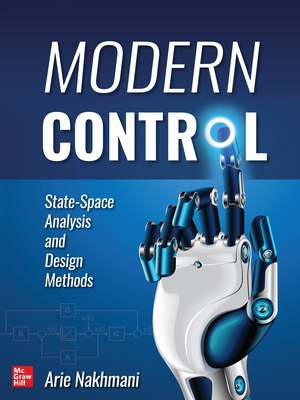Control System Design: An Introduction to State-Space Methods (Paperback)
暫譯: 控制系統設計:狀態空間方法入門 (平裝本)
Bernard Friedland
- 出版商: Dover Publications
- 出版日期: 2005-03-24
- 售價: $1,440
- 貴賓價: 9.5 折 $1,368
- 語言: 英文
- 頁數: 528
- 裝訂: Paperback
- ISBN: 0486442780
- ISBN-13: 9780486442785
無法訂購
買這商品的人也買了...
-
 深入淺出設計模式 (Head First Design Patterns)
深入淺出設計模式 (Head First Design Patterns)$880$695 -
 Thinking in Java 中文版 (Thinking in Java, 4/e)
Thinking in Java 中文版 (Thinking in Java, 4/e)$960$758 -
 鳥哥的 Linux 私房菜-基礎學習篇, 3/e
鳥哥的 Linux 私房菜-基礎學習篇, 3/e$820$648 -
 系統程式
系統程式$480$432 -
 Excel 2010 新私房教師:絕對用得著的超實用範例
Excel 2010 新私房教師:絕對用得著的超實用範例$450$356 -
 Embedded Linux 嵌入式系統開發實務, 2/e (Embedded Linux Primer: A Practical Real-World Approach, 2/e)
Embedded Linux 嵌入式系統開發實務, 2/e (Embedded Linux Primer: A Practical Real-World Approach, 2/e)$780$663 -
 STM32F4-Discovery
STM32F4-Discovery$680$666 -
 JSP 2.2 動態網頁技術, 4/e
JSP 2.2 動態網頁技術, 4/e$580$452 -
 笑談軟體工程:敏捷開發法的逆襲-導入 Scrum,讓你的軟體開發人生從黑白變彩色!
笑談軟體工程:敏捷開發法的逆襲-導入 Scrum,讓你的軟體開發人生從黑白變彩色!$550$435 -
 Excel VBA 一點都不難:一鍵搞定所有報表
Excel VBA 一點都不難:一鍵搞定所有報表$380$296 -
 超圖解 Arduino 互動設計入門, 2/e
超圖解 Arduino 互動設計入門, 2/e$680$578 -
 改變世界的九大演算法 : 讓今日電腦無所不能的最強概念 (Nine Algorithms That Changed the Future: The Ingenious Ideas That Drive Today’s Computers)
改變世界的九大演算法 : 讓今日電腦無所不能的最強概念 (Nine Algorithms That Changed the Future: The Ingenious Ideas That Drive Today’s Computers)$360$284 -
 如何設計好網站-Don't Make Me Think (Don't Make Me Think, Revisited: A Common Sense Approach to Web Usability, 3/e)
如何設計好網站-Don't Make Me Think (Don't Make Me Think, Revisited: A Common Sense Approach to Web Usability, 3/e)$480$408 -
 Raspberry Pi 最佳入門與實戰應用-深入 Raspberry Pi 的全方位指南(附87段教學與執行影片/範例程式檔)
Raspberry Pi 最佳入門與實戰應用-深入 Raspberry Pi 的全方位指南(附87段教學與執行影片/範例程式檔)$450$356 -
 啊哈!圖解演算法必學基礎
啊哈!圖解演算法必學基礎$350$298 -
 ASP.NET MVC 5 完全攻略
ASP.NET MVC 5 完全攻略$690$538 -
 養成 iOS 8 App 程式設計實力的 25 堂課-最新 Swift 開發教學(A Practical Guide to Building Your First App from Scratch: Beginning iOS 8 Programming with Swift)
養成 iOS 8 App 程式設計實力的 25 堂課-最新 Swift 開發教學(A Practical Guide to Building Your First App from Scratch: Beginning iOS 8 Programming with Swift)$580$452 -
 掌握行銷新趨勢 ─ 你不可不知的網站流量分析 Google Analytics
掌握行銷新趨勢 ─ 你不可不知的網站流量分析 Google Analytics$500$450 -
 Swift初學特訓班--iOS App 開發快速養成與實戰(附近3小時新手入門與關鍵影音教學/全書範例程式)
Swift初學特訓班--iOS App 開發快速養成與實戰(附近3小時新手入門與關鍵影音教學/全書範例程式)$420$332 -
 開發 Android APP 使用 App Inventor 2 輕鬆學
開發 Android APP 使用 App Inventor 2 輕鬆學$620$527 -
 Raspberry Pi 超炫專案與完全實戰 (深入 Raspberry Pi 的全面開發經典) (附101段教學與執行影片/範例程式)
Raspberry Pi 超炫專案與完全實戰 (深入 Raspberry Pi 的全面開發經典) (附101段教學與執行影片/範例程式)$520$411 -
 Android 程式設計入門、應用到精通--增訂第三版 (適用 5.X~1.X, Android Wear 穿戴式裝置)
Android 程式設計入門、應用到精通--增訂第三版 (適用 5.X~1.X, Android Wear 穿戴式裝置)$560$442 -
 精實開發與看板方法
精實開發與看板方法$550$435 -
 Android 初學特訓班, 5/e (超人氣暢銷改版,適用全新Android 5,附關鍵影音教學)
Android 初學特訓班, 5/e (超人氣暢銷改版,適用全新Android 5,附關鍵影音教學)$480$379 -
 新觀念 Android 程式設計範例教本 ─ 使用 Android Studio
新觀念 Android 程式設計範例教本 ─ 使用 Android Studio$620$527
相關主題
商品描述
Addressed not only to students but also to professional engineers and scientists, this volume introduces state-space methods for direct applications to control system design, in addition to providing background for reading the periodical literature. Its presentation, therefore, is suitable both for those who require methods for achieving results and those more interested in using results than in proving them.
Topics include feedback control; state-space representation of dynamic systems and dynamics of linear systems; frequency-domain analysis; controllability and observability; and shaping the dynamic response. Additional subjects encompass linear observers; compensator design by the separation principle; linear, quadratic optimum control; random processes; and Kalman filters.
Concrete examples of how state-space methods can be used to advantage in several representative applications are woven into the fabric of the text and the homework problems. Many of the models are drawn from aerospace and inertial instrumentation; other examples are derived from chemical process control, maritime operations, robotics, and energy systems.
Topics include feedback control; state-space representation of dynamic systems and dynamics of linear systems; frequency-domain analysis; controllability and observability; and shaping the dynamic response. Additional subjects encompass linear observers; compensator design by the separation principle; linear, quadratic optimum control; random processes; and Kalman filters.
Concrete examples of how state-space methods can be used to advantage in several representative applications are woven into the fabric of the text and the homework problems. Many of the models are drawn from aerospace and inertial instrumentation; other examples are derived from chemical process control, maritime operations, robotics, and energy systems.
商品描述(中文翻譯)
本書不僅針對學生,也針對專業工程師和科學家,介紹了狀態空間方法以直接應用於控制系統設計,並提供閱讀期刊文獻的背景。因此,其呈現方式適合那些需要方法以達成結果的人,以及那些對使用結果而非證明結果更感興趣的人。
主題包括反饋控制;動態系統的狀態空間表示法和線性系統的動力學;頻域分析;可控性和可觀性;以及塑造動態響應。其他主題包括線性觀測器;通過分離原則進行的補償器設計;線性、二次最佳控制;隨機過程;以及卡爾曼濾波器。
具體示例展示了狀態空間方法如何在幾個代表性應用中發揮優勢,這些示例融入了文本和作業問題中。許多模型來自航空航天和慣性儀器;其他示例則源自化學過程控制、海事操作、機器人技術和能源系統。












